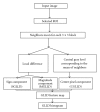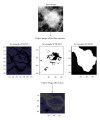A New GLLD Operator for Mass Detection in Digital Mammograms
- PMID: 23365556
- PMCID: PMC3539378
- DOI: 10.1155/2012/765649
A New GLLD Operator for Mass Detection in Digital Mammograms
Abstract
During the last decade, several works have dealt with computer automatic diagnosis (CAD) of masses in digital mammograms. Generally, the main difficulty remains the detection of masses. This work proposes an efficient methodology for mass detection based on a new local feature extraction. Local binary pattern (LBP) operator and its variants proposed by Ojala are a powerful tool for textures classification. However, it has been proved that such operators are not able to model at their own texture masses. We propose in this paper a new local pattern model named gray level and local difference (GLLD) where we take into consideration absolute gray level values as well as local difference as local binary features. Artificial neural networks (ANNs), support vector machine (SVM), and k-nearest neighbors (kNNs) are, then, used for classifying masses from nonmasses, illustrating better performance of ANN classifier. We have used 1000 regions of interest (ROIs) obtained from the Digital Database for Screening Mammography (DDSM). The area under the curve of the corresponding approach has been found to be A(z) = 0.95 for the mass detection step. A comparative study with previous approaches proves that our approach offers the best performances.
Figures










Similar articles
-
Mass detection in digital breast tomosynthesis: Deep convolutional neural network with transfer learning from mammography.Med Phys. 2016 Dec;43(12):6654. doi: 10.1118/1.4967345. Med Phys. 2016. PMID: 27908154 Free PMC article.
-
False-positive reduction in computer-aided mass detection using mammographic texture analysis and classification.Comput Methods Programs Biomed. 2018 Jul;160:75-83. doi: 10.1016/j.cmpb.2018.03.026. Epub 2018 Mar 31. Comput Methods Programs Biomed. 2018. PMID: 29728249
-
Mass type-specific sparse representation for mass classification in computer-aided detection on mammograms.Biomed Eng Online. 2013;12 Suppl 1(Suppl 1):S3. doi: 10.1186/1475-925X-12-S1-S3. Epub 2013 Dec 9. Biomed Eng Online. 2013. PMID: 24564973 Free PMC article.
-
Simultaneous detection and classification of breast masses in digital mammograms via a deep learning YOLO-based CAD system.Comput Methods Programs Biomed. 2018 Apr;157:85-94. doi: 10.1016/j.cmpb.2018.01.017. Epub 2018 Jan 31. Comput Methods Programs Biomed. 2018. PMID: 29477437
-
Computer-aided mass detection in mammography: false positive reduction via gray-scale invariant ranklet texture features.Med Phys. 2009 Feb;36(2):311-6. doi: 10.1118/1.3049588. Med Phys. 2009. PMID: 19291970
Cited by
-
Predicting tooth surface loss using genetic algorithms-optimized artificial neural networks.Comput Math Methods Med. 2014;2014:106236. doi: 10.1155/2014/106236. Epub 2014 Jul 10. Comput Math Methods Med. 2014. PMID: 25114713 Free PMC article.
References
-
- Eurostat. Health statistics—Atlas on mortality in the European Union. European Commission, 2002.
-
- American Cancer Society. Cancer Facts and Figures 2012. American Cancer Society, Atlanta, Ga, USA, 2012.
-
- Esteve J, Kricker A, Ferlay J, Parkin D. Facts and figures of cancer in the European community. International Agency for Research on Cancer, Lyon, France, 1993.
-
- Mourali N. Haro sur la première cause de mortalité dans le monde. Livret Santé. 2010.
-
- Sickles EA. Breast cancer screening outcomes in women ages 40–49: clinical experience with service screening using modern mammography. Journal of the National Cancer Institute. Monographs. 1997;(22):99–104. - PubMed
LinkOut - more resources
Full Text Sources
Miscellaneous

